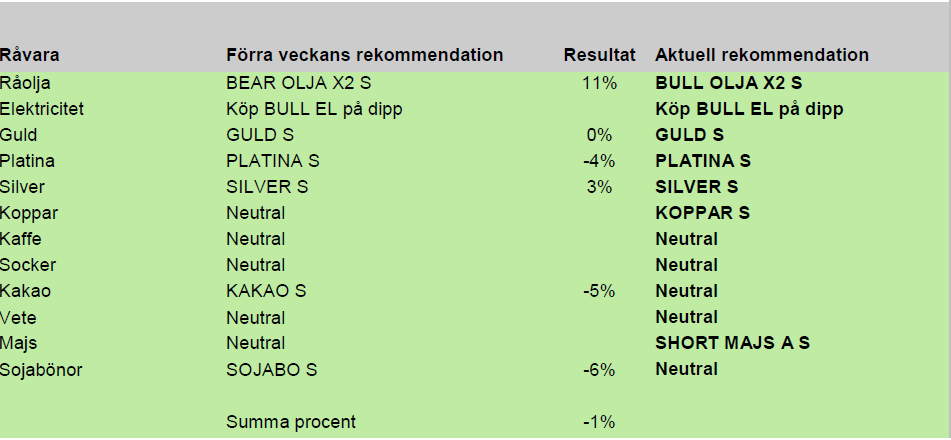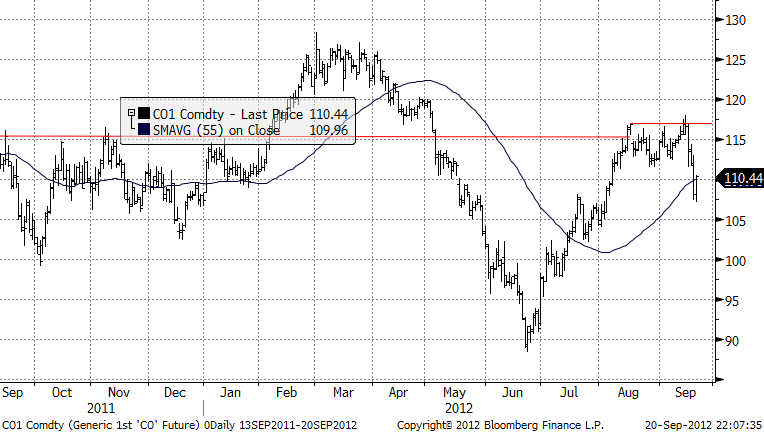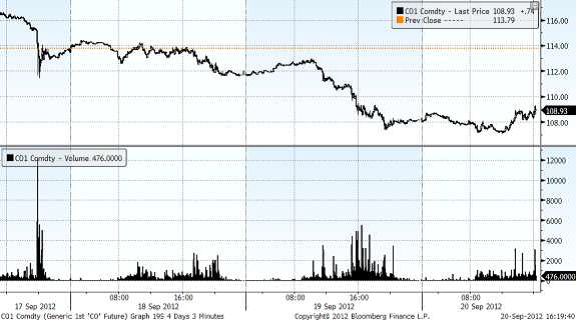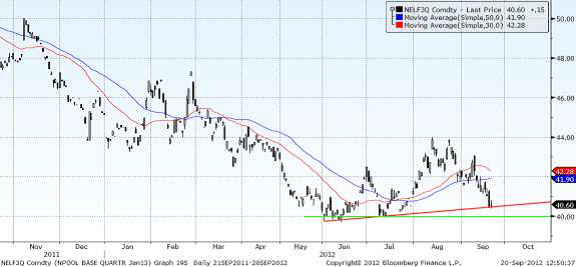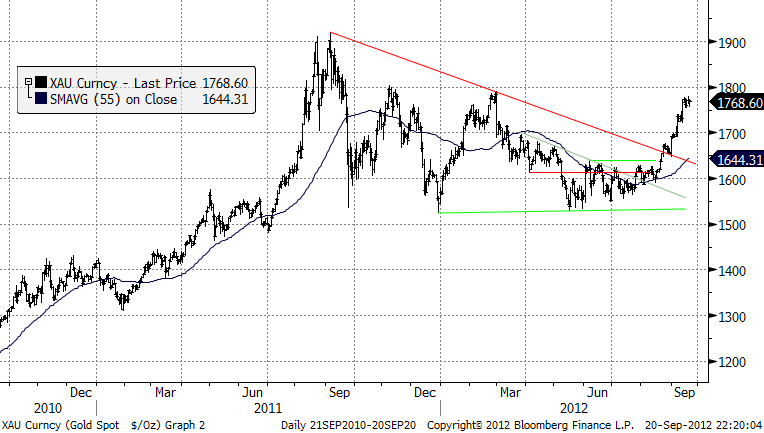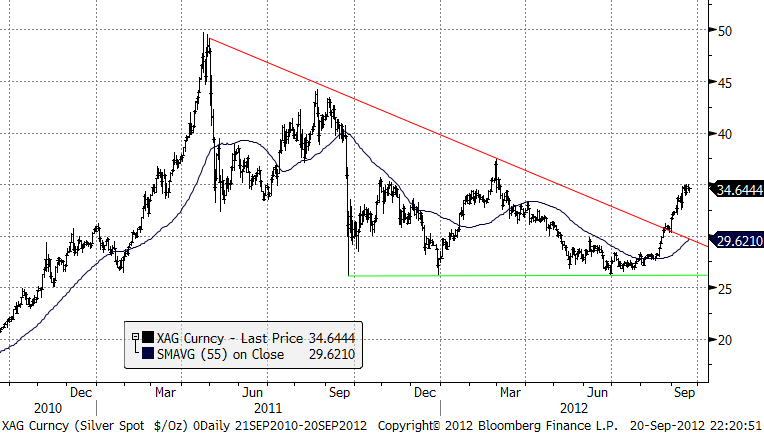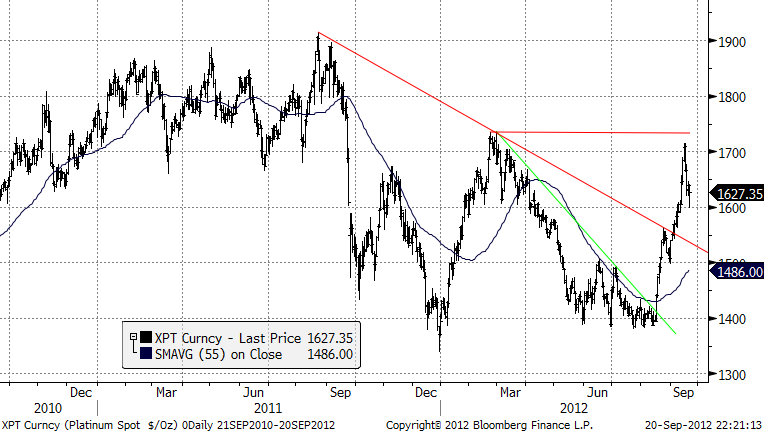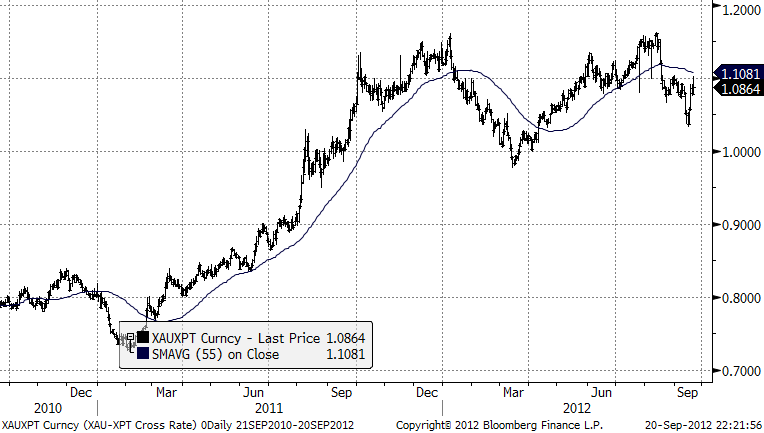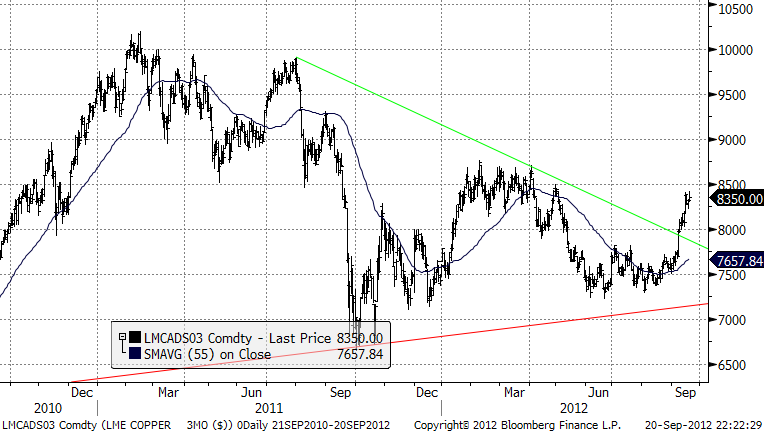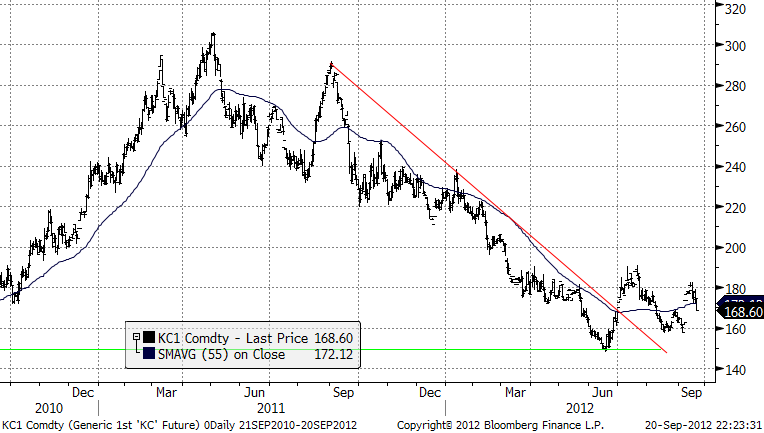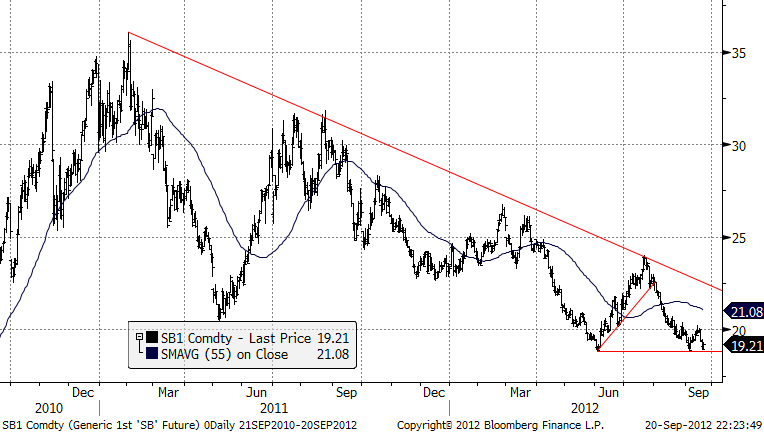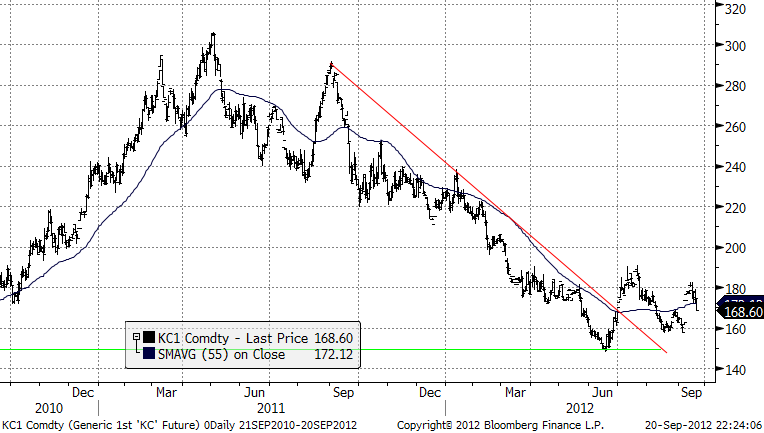Analys
SEB – Råvarukommentarer, 21 september 2012
Sammanfattning av rekommendationer
Summan av resultatet blev en liten förlust i veckan på -1%. Vi börjar bli något mer positiva till el jämfört med förra veckan. Efter rekylen i oljepriset är vi positiva till den också. Jordbruksprodukterna har successivt glidit över från köp- till neutral och nu sälj på majs. Möjligtvis kan det komma en rekyl upp på majs, vilket då blir ett säljtillfälle. För ädelmetaller är vi positiva. De gynnas på ett uppenbart sätt av monetär stimulans (“utan begränsning”) i USA, i Europa och i Japan.
Råolja – Brent
Brentkontraktet har, under en månads tid, fram till i måndags, handlats mellan 112 och 117 usd. Trots massiva stimulanser från FED och framgångarna i det europeiska arbetet mot en bankunion, har inte oljemarknaden lyckats bryta ur intervallet. Stundtals sökte sig priset ovan 117 men trycktes genast ned igen.
Vi har under en tid ansett att råoljan varit för högt prissatt. Det som mest drivit priset högre är utbudsstörningar i Nordsjön, stormen Isaac samt geopolitisk oro i Mellanöstern med sanktionerna mot Iran som största bidragare. Nu senast har ny oro tillkommit med de starka reaktionerna på Mohammed filmen. Samtidigt har Saudiarabien och bland annat Irak, producerat olja som mer än väl kompenserat bortfallet från Iran.
I förra veckan var all fokus på Federal Reserve, som också levererade, i linje med- eller mer än vad marknaden förväntat sig. Många tillgångsslag, inte minst metaller gick mycket starkt, både inför och efter FED beskedet. Oljan däremot var mer återhållen. Visserligen handlade man i en den övre delen av intervallet.
Därefter har dramatiken varit mycket stor. Det började med att amerikansk WTI olja på bara några minuter föll handlöst med 3-4 usd under extremt hög omsättning, se graf nedan. Teorierna kring vad som skedde är många, bland annat anges robothandel, ”fat fingers” och optionslösen som möjliga utlösande faktorer. Nymex ska ha inlett en undersökning. När den värsta röken lagt sig, så verkar det ändå som att även uttalanden och åtgärder från Saudiarabien, vilken länge agerat och argumenterat för lägre pris bidragit samt att marknaden, länge, faktiskt, negligerat negativ information. Kinesisk statistik visar bland annat på en svag utveckling i världens fabrik. I onsdags tilltog fallet då amerikansk oljelagerstatistik visade en mycket stor uppgång, +8.5 miljoner fat (mot förväntade +1.0) för råolja. Brent föll ned mot 107 men har sedan dess återhämtats och noteras senast på 109 usd.
I nuläget förhåller vi oss neutral men ser nivåer kring 105 USD som en mycket attraktiv nivå för en lång position.
Elektricitet
Elmarknaden har fortsatt nedåt och vi börjar närma oss nivåer för att börja bygga längd. Q1-13 terminen är senast omsatt på 40.70 EUR/MWh (tidigare kommunicerad target-nivå 40.00). Nedsidan börjar bli begränsad och vi står beredda på att köpa.
Väderprognoserna indikerar nu kallare och torrare väder och marginalkostnaden för koleldad elproduktion (MC kol), se graf nedan, vilken är en mycket viktig prisinput för de längre terminerna, har planat ut.
Just väderskifte och uppgång i MC kol är två viktiga ”triggers” för en prisuppgång. Q1-13 terminen på börsen har ännu inte stigit eller ens planat ut. Oftast brukar marknaden vara mycket snabb att ta till sig förändringar som dessa men än så länge är reaktionen väldigt försiktig. Vi räknar ändå med att uppsidan kan komma att bli explosiv, om än kanske kortvarig, varför en eventuell vinst bör tas hem relativt snabbt. En återgång till våtare/varmare väder kommer resultera i snabb korrektion ned igen. Brott av 40.00 nivån kan också öppna upp för större prisfall.
Vi håller fortsatt en neutral rekommendation men gör oss beredda att köpa.
Guld och Silver
Efter den initiala reaktionen efter FED har guld och silver inte orkat klättra vidare. Många aktörer som köpt på förväntningar om ytterligare stimulanser har legat beredda att ta hem vinster. Det gamla ordspråket ”buy the rumour and sell the fact” verkar gälla den har veckan. Undertonen är ändå stark och rekylerna endast marginella. Vi bedömer att priserna har fortsatt mer att ge med nivån $1800 inom räckhåll för guld (spot i London handlas kring $1862 i skrivandes stund). En tänkbar strategi (för den som inte redan köpt) är att bevaka den tidigare högsta nivån $1780 och agera på ett genombrott. Scenariot är likartat för silver med rekommenderad bevakning av förra veckans toppnivå på $35/oz ($34,50 i skrivandes stund).
Nedan ser vi kursdiagrammet för guld i dollar per troy ounce.
Nedan ser vi kursdiagrammet för silver i dollar per troy ounce.
Platina
Nyheten att Strejken vid Lonmins gruva i Sydafrika avblåstes i början av veckan ledde till en massiv våg av vinsthemtagningar i platina. Priset har rekylerat ner ca 6 % sen toppen i förra veckan – detta efter en oavbruten uppgång sen mitten av augusti med mer än 20 % över perioden. Vi bedömer dagens nivå, strax över $1600, som klart köpvärd. Oroligheterna i Sydafrika, som står för 75 % av världsutbudet, är inte över, och strejkhoten hänger över fler gruvor efter Lonmins uppgörelse. Gruvorna har redan lönsamhetsproblem (går med förlust) och risken för fortsatt minskat utbud i landet är stor. Vi ser den här rekylen som ett köptillfälle.
Nedan ser vi priset på guld dividerat med priset på platina. Vi ser att guld har utvecklats sämre än platina sedan mitten av augusti. Tekniskt ser den här trenden stark ut och har potential att gå från 1.05 till 1, dvs en outperformance på ytterligare 5% till platinas fördel. Det mesta av rörelsen från 1.15 är dock avklarad och platina har inte lång tid kvar att vara vår favorit bland ädelmetallerna.
Koppar
Effekten av FED:s penningpolitiska stimulanspaket slog igenom fullt ut förra fredagen med kraftiga prisuppgångar för både bas- och ädelmetaller. Veckan stängde på toppnivåer över hela linjen.
Efter en helg med eftertänksamhet och i viss mån ett uppvaknande med en industriell aktivitet globalt, som faktiskt är under avmattning, var stämningsläget mer avvaktande under denna vecka. Bank of Japan följde upp med ett paket natten mellan tisdag och onsdag, vilket ingav visst mod igen. Oljemarknaden har förbryllat många aktörer och går mot strömmen. Måndagskvällens något oförklarliga ras (oljan föll 4 % inom loppet av ett par minuter), följdes upp av ett kraftigt prisfall på onsdagskvällen, bl.a. efter större lagerökningar i USA än väntat. Oljefallet spred sig till metallerna som dessutom tappade mark efter en svag inköpschefsindex från Kina.
Priserna har nu överlag kommit tillbaka 1-4 % efter uppgångar i storleksordningen 10 % de senaste två veckorna. Undertonen är fortsatt stark med stöd av stimulanser. Nu måste den verkliga fysiska efterfrågan också komma ifatt. Än så länge är det lite tveksamt och marknaden kommer stå och väga för och emot de närmsta dagarna. Koppar är faktiskt upp sedan förra brevet och handlas idag torsdag till $8278 ($3,75(Lbs).
Toppnoteringen förra fredagen noterades till $8422. Marknaden har således endast fallit marginellt. Vi bedömer att finansiella aktörer som tidigare spekulerat i nedgång, nu har återköpt positioner. Tekniska fonder har börjat gå långa.
Industrin är än så länge avvaktande och brottas med en prisuppgång som inte riktigt speglar den
fundamentala situationen, och i många fall överstiger lagda budgetnivåer. Frågan är när (och om) industrin tvingas ”bita i det sura äpplet” och täcka in framtida behov. Centralbankerna visar att de menar allvar och stimulanserna fortsätter. Aktörerna väntar på mer från Kina. Mycket talar för en fortsatt stark trend i nästa vecka med test av nivåer upp mot $8500.
Vi väljer att på kort sikt rekommendera en lång position i koppar.
Kaffe
Kaffepriset har fortsatt att falla vilket till största del beror på att världens största kaffeproducent Brasilien har valt att gradvis sälja landets överskott av kaffe efter den senaste tidens prisuppgång. Som världens största kaffeodlande land står Brasilien för hela 25 procent av världens kaffeproduktion och ungefär 80 procent av landets produktion utgörs av arabicabönan.
Enligt Agriculture Ministry i Brasilien förväntas årets skörd motsvara 50,5 miljoner bags jämfört med 43,5 miljoner bags för samma period föregående år, en bag kaffe motsvarar cirka 60 kg. Skörden i Brasilien sträcker sig från april till september. En ökad export från Brasilien som en följd av försvagningen av landets valuta har bidragit till det lägre priset. Den ekonomiska osäkerhet som råder globalt väger också tungt på kaffemarknaden.
Socker
Priset på socker har fallit 3 procent under veckan som gått och handlar nu strax över 20 US cents per pound.
Som vi nämnt ovan så förväntas El Niño bli mild och således inte att medföra större produktionsstörningar i sockerproducerande länder. Terminskontrakt på socker i New York föll till tvåårslägsta efter att torrt väder och lagom mycket regn i Brasilien, världens största sockerproducent, gynnat utvinning av socker från sockerrör. Monsunregn i Indien, världens andra största sockerproducent, ökade förväntningarna på kommande skörd. Den förväntade utbudsökning har pressat ned priset på socker. Förra årets rekordhöga priser ledde till att Kina kraftigt ökade sockerproduktionen. Landet är världens största sockerimportör men kommer efter årets förväntade rekordskörd att minska importen och istället bli en nettoexportör. Sockerskörden i Kina inleds under oktober månad.
För 2012/13 spår International Sugar Organization ett globalt utbudsöverskott på 5,9 miljoner ton, något som begränsar uppsidepotentialen på socker.
Kakao
Kakaopriset fortsatte att falla efter förväntat regn i Elfenbenskusten och Ghana, världens största kakaoproducenter, vilket ökat förhoppningarna om skörden. Väderutsikterna i länderna de närmaste månaderna är avgörande för prisutvecklingen. Historiskt ser vi höga priser och stora investeringar har gjorts i Ghana vilket kan begränsa uppsidan.
Kakaomarknaden är en mycket oförutsägbar och känslig marknad där åtskilliga faktorer påverkar priset.
Flera av de kakaoproducerande länderna lider av inhemska oroligheter och det krävs stora investeringar och långsiktighet för att ett kakaoträd ska bära frukt. Produktionen är ofta kantad av protester och strejker om bättre arbetsförhållanden och träden är dessutom känsliga för sjukdomar.
Kakaopriset finner visst stöd från de diskussioner som förs mellan IMF och Elfenbenskustens Coffee and Cocoa Council, där det råder viss oenighet kring frakt av kakao. Exportörer som köpt kakao på landets elektroniska börs är inte säkra på att de verkligen får kakaon levererad.
Vi väljer att vara neutrala i kakao till nästa vecka.
Politik på agrimarknaden
Frankrike har kallat till ett krismöte med G20’s jordbruksministrar i mitten av oktober i Rom på för att diskutera hur man ska kunna bromsa de kraftiga prissvängningarna i spannmålsmarknaden, efter att årets torka och rekordhöga priser har skapat nya farhågor om en global matkris. Uttalandet kom efter samtal mellan Frankrikes president Francois Hollande och Jose Graziano da Silva, generaldirektör för FN:s livsmedels- och jordbruksorganisation (FAO). Flera förslag har lagts fram under de senaste dagarna, bland annat utveckling av strategiska lager och ett stopp i expanderingen av biobränsle som tillverkas av matgrödor.
För spannmål och övriga jordbruksprodukter hänvisas till gårdagens nyhetsbrev om jordruksprodukter.
[box]SEB Veckobrev Veckans råvarukommentar är producerat av SEB Merchant Banking och publiceras i samarbete och med tillstånd på Råvarumarknaden.se[/box]
Disclaimer
The information in this document has been compiled by SEB Merchant Banking, a division within Skandinaviska Enskilda Banken AB (publ) (“SEB”).
Opinions contained in this report represent the bank’s present opinion only and are subject to change without notice. All information contained in this report has been compiled in good faith from sources believed to be reliable. However, no representation or warranty, expressed or implied, is made with respect to the completeness or accuracy of its contents and the information is not to be relied upon as authoritative. Anyone considering taking actions based upon the content of this document is urged to base his or her investment decisions upon such investigations as he or she deems necessary. This document is being provided as information only, and no specific actions are being solicited as a result of it; to the extent permitted by law, no liability whatsoever is accepted for any direct or consequential loss arising from use of this document or its contents.
About SEB
SEB is a public company incorporated in Stockholm, Sweden, with limited liability. It is a participant at major Nordic and other European Regulated Markets and Multilateral Trading Facilities (as well as some non-European equivalent markets) for trading in financial instruments, such as markets operated by NASDAQ OMX, NYSE Euronext, London Stock Exchange, Deutsche Börse, Swiss Exchanges, Turquoise and Chi-X. SEB is authorized and regulated by Finansinspektionen in Sweden; it is authorized and subject to limited regulation by the Financial Services Authority for the conduct of designated investment business in the UK, and is subject to the provisions of relevant regulators in all other jurisdictions where SEB conducts operations. SEB Merchant Banking. All rights reserved.
Analys
Tightening fundamentals – bullish inventories from DOE

The latest weekly report from the US DOE showed a substantial drawdown across key petroleum categories, adding more upside potential to the fundamental picture.

Commercial crude inventories (excl. SPR) fell by 5.8 million barrels, bringing total inventories down to 415.1 million barrels. Now sitting 11% below the five-year seasonal norm and placed in the lowest 2015-2022 range (see picture below).
Product inventories also tightened further last week. Gasoline inventories declined by 2.1 million barrels, with reductions seen in both finished gasoline and blending components. Current gasoline levels are about 3% below the five-year average for this time of year.
Among products, the most notable move came in diesel, where inventories dropped by almost 4.1 million barrels, deepening the deficit to around 20% below seasonal norms – continuing to underscore the persistent supply tightness in diesel markets.
The only area of inventory growth was in propane/propylene, which posted a significant 5.1-million-barrel build and now stands 9% above the five-year average.
Total commercial petroleum inventories (crude plus refined products) declined by 4.2 million barrels on the week, reinforcing the overall tightening of US crude and products.


Analys
Bombs to ”ceasefire” in hours – Brent below $70

A classic case of “buy the rumor, sell the news” played out in oil markets, as Brent crude has dropped sharply – down nearly USD 10 per barrel since yesterday evening – following Iran’s retaliatory strike on a U.S. air base in Qatar. The immediate reaction was: “That was it?” The strike followed a carefully calibrated, non-escalatory playbook, avoiding direct threats to energy infrastructure or disruption of shipping through the Strait of Hormuz – thus calming worst-case fears.

After Monday morning’s sharp spike to USD 81.4 per barrel, triggered by the U.S. bombing of Iranian nuclear facilities, oil prices drifted sideways in anticipation of a potential Iranian response. That response came with advance warning and caused limited physical damage. Early this morning, both the U.S. President and Iranian state media announced a ceasefire, effectively placing a lid on the immediate conflict risk – at least for now.
As a result, Brent crude has now fallen by a total of USD 12 from Monday’s peak, currently trading around USD 69 per barrel.
Looking beyond geopolitics, the market will now shift its focus to the upcoming OPEC+ meeting in early July. Saudi Arabia’s decision to increase output earlier this year – despite falling prices – has drawn renewed attention considering recent developments. Some suggest this was a response to U.S. pressure to offset potential Iranian supply losses.
However, consensus is that the move was driven more by internal OPEC+ dynamics. After years of curbing production to support prices, Riyadh had grown frustrated with quota-busting by several members (notably Kazakhstan). With Saudi Arabia cutting up to 2 million barrels per day – roughly 2% of global supply – returns were diminishing, and the risk of losing market share was rising. The production increase is widely seen as an effort to reassert leadership and restore discipline within the group.
That said, the FT recently stated that, the Saudis remain wary of past missteps. In 2018, Riyadh ramped up output at Trump’s request ahead of Iran sanctions, only to see prices collapse when the U.S. granted broad waivers – triggering oversupply. Officials have reportedly made it clear they don’t intend to repeat that mistake.
The recent visit by President Trump to Saudi Arabia, which included agreements on AI, defense, and nuclear cooperation, suggests a broader strategic alignment. This has fueled speculation about a quiet “pump-for-politics” deal behind recent production moves.
Looking ahead, oil prices have now retraced the entire rally sparked by the June 13 Israel–Iran escalation. This retreat provides more political and policy space for both the U.S. and Saudi Arabia. Specifically, it makes it easier for Riyadh to scale back its three recent production hikes of 411,000 barrels each, potentially returning to more moderate increases of 137,000 barrels for August and September.
In short: with no major loss of Iranian supply to the market, OPEC+ – led by Saudi Arabia – no longer needs to compensate for a disruption that hasn’t materialized, especially not to please the U.S. at the cost of its own market strategy. As the Saudis themselves have signaled, they are unlikely to repeat previous mistakes.
Conclusion: With Brent now in the high USD 60s, buying oil looks fundamentally justified. The geopolitical premium has deflated, but tensions between Israel and Iran remain unresolved – and the risk of missteps and renewed escalation still lingers. In fact, even this morning, reports have emerged of renewed missile fire despite the declared “truce.” The path forward may be calmer – but it is far from stable.
Analys
A muted price reaction. Market looks relaxed, but it is still on edge waiting for what Iran will do

Brent crossed the 80-line this morning but quickly fell back assigning limited probability for Iran choosing to close the Strait of Hormuz. Brent traded in a range of USD 70.56 – 79.04/b last week as the market fluctuated between ”Iran wants a deal” and ”US is about to attack Iran”. At the end of the week though, Donald Trump managed to convince markets (and probably also Iran) that he would make a decision within two weeks. I.e. no imminent attack. Previously when when he has talked about ”making a decision within two weeks” he has often ended up doing nothing in the end. The oil market relaxed as a result and the week ended at USD 77.01/b which is just USD 6/b above the year to date average of USD 71/b.

Brent jumped to USD 81.4/b this morning, the highest since mid-January, but then quickly fell back to a current price of USD 78.2/b which is only up 1.5% versus the close on Friday. As such the market is pricing a fairly low probability that Iran will actually close the Strait of Hormuz. Probably because it will hurt Iranian oil exports as well as the global oil market.
It was however all smoke and mirrors. Deception. The US attacked Iran on Saturday. The attack involved 125 warplanes, submarines and surface warships and 14 bunker buster bombs were dropped on Iranian nuclear sites including Fordow, Natanz and Isfahan. In response the Iranian Parliament voted in support of closing the Strait of Hormuz where some 17 mb of crude and products is transported to the global market every day plus significant volumes of LNG. This is however merely an advise to the Supreme leader Ayatollah Ali Khamenei and the Supreme National Security Council which sits with the final and actual decision.
No supply of oil is lost yet. It is about the risk of Iran closing the Strait of Hormuz or not. So far not a single drop of oil supply has been lost to the global market. The price at the moment is all about the assessed risk of loss of supply. Will Iran choose to choke of the Strait of Hormuz or not? That is the big question. It would be painful for US consumers, for Donald Trump’s voter base, for the global economy but also for Iran and its population which relies on oil exports and income from selling oil out of that Strait as well. As such it is not a no-brainer choice for Iran to close the Strait for oil exports. And looking at the il price this morning it is clear that the oil market doesn’t assign a very high probability of it happening. It is however probably well within the capability of Iran to close the Strait off with rockets, mines, air-drones and possibly sea-drones. Just look at how Ukraine has been able to control and damage the Russian Black Sea fleet.
What to do about the highly enriched uranium which has gone missing? While the US and Israel can celebrate their destruction of Iranian nuclear facilities they are also scratching their heads over what to do with the lost Iranian nuclear material. Iran had 408 kg of highly enriched uranium (IAEA). Almost weapons grade. Enough for some 10 nuclear warheads. It seems to have been transported out of Fordow before the attack this weekend.
The market is still on edge. USD 80-something/b seems sensible while we wait. The oil market reaction to this weekend’s events is very muted so far. The market is still on edge awaiting what Iran will do. Because Iran will do something. But what and when? An oil price of 80-something seems like a sensible level until something do happen.
-

 Nyheter4 veckor sedan
Nyheter4 veckor sedanUppgången i oljepriset planade ut under helgen
-

 Nyheter3 veckor sedan
Nyheter3 veckor sedanMahvie Minerals växlar spår – satsar fullt ut på guld
-

 Nyheter4 veckor sedan
Nyheter4 veckor sedanLåga elpriser i sommar – men mellersta Sverige får en ökning
-

 Nyheter2 veckor sedan
Nyheter2 veckor sedanOljan, guldet och marknadens oroande tystnad
-

 Nyheter2 veckor sedan
Nyheter2 veckor sedanJonas Lindvall är tillbaka med ett nytt oljebolag, Perthro, som ska börsnoteras
-

 Analys4 veckor sedan
Analys4 veckor sedanVery relaxed at USD 75/b. Risk barometer will likely fluctuate to higher levels with Brent into the 80ies or higher coming 2-3 weeks
-

 Analys3 veckor sedan
Analys3 veckor sedanA muted price reaction. Market looks relaxed, but it is still on edge waiting for what Iran will do
-

 Nyheter2 veckor sedan
Nyheter2 veckor sedanDomstolen ger klartecken till Lappland Guldprospektering



